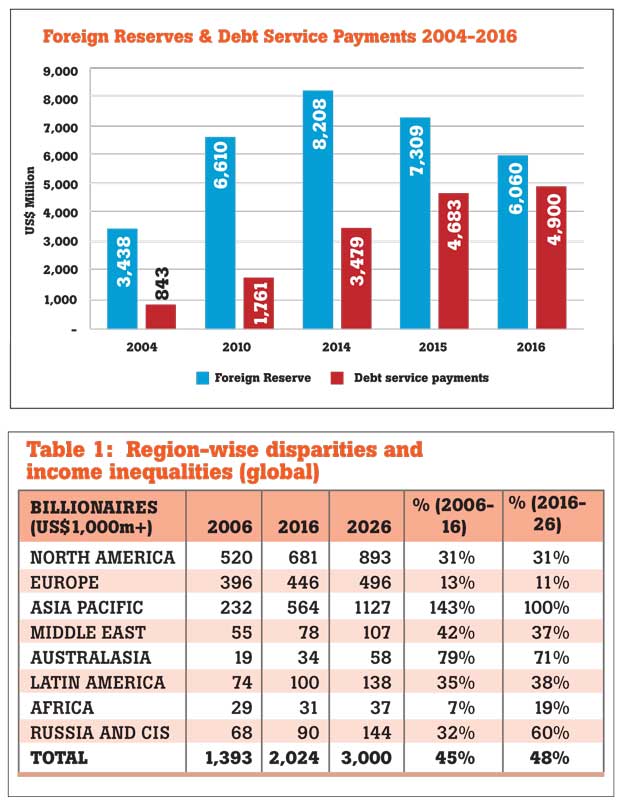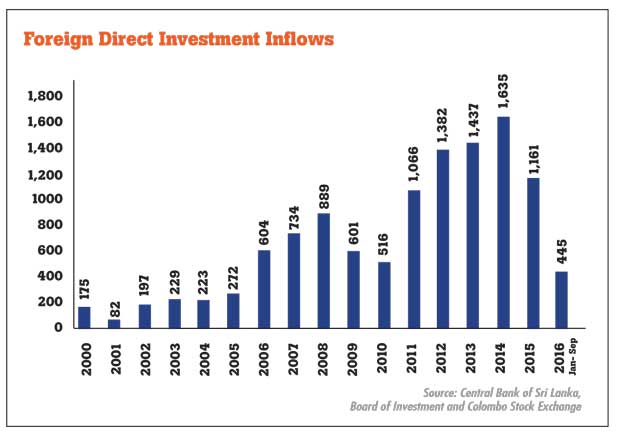21 Mar 2017 - {{hitsCtrl.values.hits}}

 My predictions are that the political surprises in 2016, which include Brexit and Donald Trump’s US elections, will continue in 2017 as well with elections in France and Germany. The perception is the ‘West’ turns inward with growing uncertainty over the threat of protectionism. The votes for both Brexit and Trump last year were held up as examples of globalization being in reverse gear. On the other hand, China is looking forward to expand its influence across the world with its ‘one road-one belt’ maritime silk route strategy.
My predictions are that the political surprises in 2016, which include Brexit and Donald Trump’s US elections, will continue in 2017 as well with elections in France and Germany. The perception is the ‘West’ turns inward with growing uncertainty over the threat of protectionism. The votes for both Brexit and Trump last year were held up as examples of globalization being in reverse gear. On the other hand, China is looking forward to expand its influence across the world with its ‘one road-one belt’ maritime silk route strategy.
World will become more globalized
The Chinese President Xi Jinping at the opening plenary sessions of the World Economic Forum in Davos, Switzerland this January declared that ‘Devos’ is an important window for taking the pulse of the global economy.
Quote. “Today, we also live in a world of contradictions. On the one hand, with growing material wealth and advances in science and technology, human civilization has developed as never before. On the other hand, frequent regional conflicts, global challenges like terrorism and refugees, as well as poverty, unemployment and widening income gap have all added to the uncertainties of the world.” Unquote.
The point he wanted to stress was that many of the problems troubling the world are not caused by economic globalization. “Just blaming economic globalization for the world’s problems is inconsistent with reality and it will not help solve the problems.” He emphasized, in a philosophical sense that nothing is perfect in the world.
According to Parag Khanna, global strategist and bestselling author, contrary to popular belief, the world will become more globalized. His view is these votes were votes against London and Washington’s mismanagement of globalization rather than against globalization itself, from which everyone benefits on the whole.
His argument is that there will be more pressure from governments for investment into areas like energy, industry and real estate, both for (a) creating jobs and (b) the secondary economic activity it will stimulate. His studies have revealed a future growth area, investing in emerging markets based on the demographic trends of urbanization and investing in infrastructure in non-core districts of major cities. Nevertheless, income inequalities have become a major phenomenon in the global world.

Latest studies on income inequality
In order to understand why inequality seems to be reaching alarming levels, it is worth reading the book written by an eminent French economist, Thomas Piketty’s (Professor at the Paris School of Economics) ‘Capital in the Twenty-First Century’ - 2014, Harvard Publication. He has collected and analysed data, including tax records, to show just how extreme the disparity in wealth between the rich and the rest of the population has grown.
The Wealth Report 2017 by ‘Knight Frank’ has also revealed the latest intelligence on the world’s wealthiest people. Look at the growth of the billionaires regional wise taken from the report just released.
As can be seen from Table 1, there were 2,024 billionaires (US $ 1,000m+) in 2016 and it will increase to 3,000 wealthiest people by 2026, which is a 48 percent increase from the 2016 figure. What is important to realize is that as for the Asia Pacific region, the increase would be 100 percent and by 2026, the wealthiest people figure will rise to 1,127 out of the 3,000 in the whole world.
Even according to ‘Forbes’, the number of US $ billionaires (between 1987 and 2013), rose from 140 to 1,400 and their total wealth rose from US $ 300 to 5,400 billion. At country level, Sri Lanka does not have a single billionaire; however there were 10 wealthiest people (Centa Millionaires - above US $ 100 million) in 2016, which is expected to increase to 26 richest people by 2026.
Coming back to Piketty’s great work, the prestigious Economist magazine hailed ‘Capital in the Twenty-First Century’; ‘Economist’ says it is the economics book that took the world by storm. Quote. “The pile of data allows Piketty to sketch out the evolution of inequality since the beginning of the industrial revolution.” Unquote.
Growth of social states and investing in people
Piketty has done a detailed research covering a period 1870 till 2010. As per his studies, total tax revenues were less than 10 percent of national income in rich countries until 1900–1910; now they represent between 30 percent and 55 percent of national income during the period 2000–2010. The taxes were less than 10 percent of national income in the US, Britain, France and Sweden during the 19th century and up to World War I. This reflects the fact that the state at that time had very little involvement in economic and social life (police, courts, army, foreign affairs, etc.).
In just half a century, the share of taxes in the national income increased by a factor of at least 3 to 5: just over 30 percent of national income in the United States, around 40 percent in Britain and between 45 and 55 percent on the European continent (45 percent in Germany, 50 percent in France and nearly 55 percent in Sweden).
In Sri Lanka, the situation is totally different. As can be seen above, those rich countries’ tax collection is around 50 percent of gross domestic product (GDP) and they in-turn invest 16 percent to 18 percent on health and education, whereas in Sri Lanka our tax revenue is around 18 percent and how much do we spend on education and health? It is true that those developed countries’ public debt to GDP is high compared with Sri Lanka (over 100 percent as opposed to Sri Lanka’s figure of 79 percent debt to GDP by 2016). But their people are rich whereas in our country, more than 25 percent of our people are living below the poverty line.
We preach that Sri Lanka is a Democratic Socialist Republic and practice social market economy. The real issue here is we have very low national savings resulting a gap between investments and savings. We need to either create a conducive business environment to attract foreign investments or borrow money in order to make investments on infrastructure development projects including improvements in health and education.
Foreign direct investments (FDIs) have come down to less than US $ 500 per annum. Some experts say our country is faced with a huge ‘debt trap’ but other intellectuals/professionals say it’s not that critical. However, the external account performance is fast deteriorating. Despite continuous borrowings, our foreign reserves are declining and debt servicing is ever increasing.
Export earnings declined for the first time in the last two decades. Trade deficit widened to US $ 9 million, however managed to finance through worker remittances and foreign exchange from tourism. Most of the top business leaders/analysts are of the view that the quality of life of not only the poor, even the middle class is drastically reducing. The income inequality and social unrest are fast spreading across the regions, sub-districts and cities. These statistics and graphs are not sufficient to explain the real downturn. The bottom line is that the successive governments have failed in bringing social justice and much-needed economic welfare to the people.
Piketty’s grand theory of capital and inequality
One of the measures to see the change in the role of government in the social sector is to look at the total tax collection from the rich and the subsidies afforded to the less-privileged people in society. As can be seen from the above, the growing tax collection has enabled the developed countries (the US, Britain, France and Sweden) to take on social welfare functions. A major portion goes to health and education – spending on education and health accounts for 12-18 percent of national income in all the developed countries today. Primary and secondary education are almost entirely free for everyone in all the rich countries but higher education can be quite expensive, especially in the United States. In all the developed countries, public spending covers much of the cost of education and health services: the goal is to give equal access to these basic goods: every child should have access to education, regardless of his or her parents’ income and everyone should have access to healthcare. From his comprehensive historical analysis, Piketty derives a grand theory of capital and inequality. As a general rule, wealth grows faster than economic output, he explains, a concept he captures in the expression: r>g (where r is the rate of return to wealth and g is the economic growth rate).
Quote. “The issue here is faster economic growth will diminish the importance of wealth in a society, whereas slower economic growth will increase it, meaning there will be more inequality.” Unquote.
According to Piketty, the rate of return to capital has always been higher than the world growth rate but the gap was reduced during the 20th century and might widen again in the 21st century.
As for Sri Lanka’s worsening, economic situation, there has been an improvement in the tax collection as a percent of GDP and one can argue that the International Monetary Fund (IMF) advocated ‘austerity programme’ has enabled the government to control fiscal deficit. Nevertheless, without burdening the poor, the authorities must focus more on collecting revenue by increasing direct taxes rather than increasing the indirect taxes such as VAT, NBT, etc. The negative side is that the GDP growth rate has further declined to 4.4 percent in the 2016. In the medium term, both the income inequality as well as the unemployment rate will further widen.
Conclusion
The ‘Capital in the Twenty-First Century’ by Piketty has provided enough analytical data and empirical evidence to our economic policymakers to compare the Sri Lankan situation with the global trends to enable them to take corrective measures. It goes without saying that improving economic growth in terms of GDP has become a necessary prerequisite to enhance the quality of life of our people.
Institute of Policy Studies Chairman Dr. Razeen Sally, who was especially brought in by the prime minister to provide advice to the government on economic policy matters, in his article in a newspaper on March 17 titled ‘Sri Lanka: Three scenarios for the future’ stated that Sri Lanka will remain a backwater and the Colombo chattering class will continue to predict stellar future achievements which will always remain unachieved.
Quote. “If the present pattern continues, Sri Lanka will drift into the future with an ossified political and business elite, highly politicized, third rate institutions, corruption and nepotism, an underperforming economy, always verging on crisis, simmering ethnic tensions and overdependence on China.” Unquote.
The Economist magazine has concluded its write up by saying that whether or not Professor Piketty succeeds in changing policy, he will have influenced the way thousands of readers and plenty of economists think about these issues. Whether Dr. Sally, Advisor on Economic Policy, will continue to criticize the country’s policies just offering ‘future scenarios’ instead of succeeding in transforming the economic pattern of Sri Lanka, is yet to be seen.
(Jayampathi Molligoda is a Fellow Member of the Institute of Chartered Accountants of Sri Lanka and he holds an FMIC Masters of Business Administration from the Post Graduate Institute of Management, University of Sri Jayewardenepura. He can be reached at [email protected])
09 Jan 2025 1 hours ago
09 Jan 2025 2 hours ago
09 Jan 2025 2 hours ago
09 Jan 2025 2 hours ago
09 Jan 2025 2 hours ago